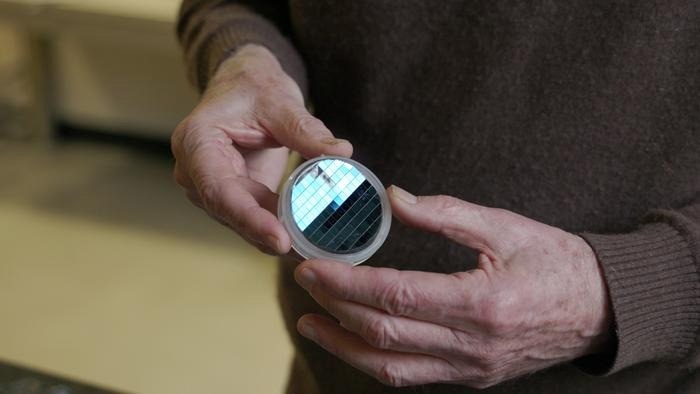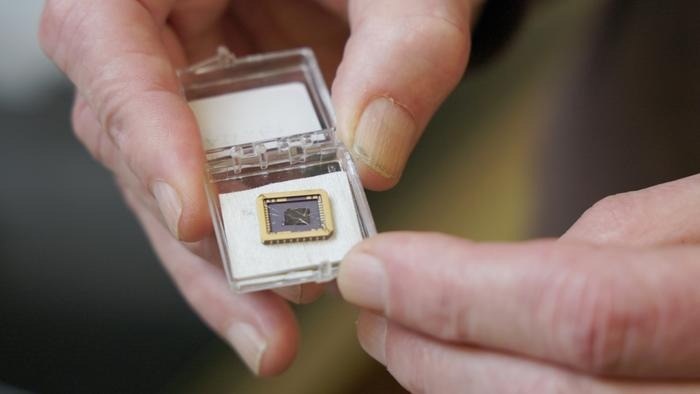The first functional semiconductor constructed from graphene, a carbon-based 2D material, has been produced by the Georgia Institute of Technology. At a time when silicon supplies are dwindling and global demands for electronics are growing, the discovery, detailed in Nature, could help to address material shortages and open the door for new manufacturing processes.

A single crystal silicon carbide wafer that has been cut into square chips. Image Credit: Georgia Institute of Technology
Semiconductors are essential to electronic technologies because they are materials that, when conditions are met, conduct electricity
Walter de Heer, Regents’ Professor of Physics at Georgia Tech, led a team of researchers from Atlanta, Georgia, and Tianjin, China, to create a graphene semiconductor compatible with traditional microelectronics processing methods–a must for any viable alternative to silicon.
de Heer and his colleagues have overcome a major obstacle that has crippled graphene research for decades, leading many to believe that graphene electronics will never function. For the first time, a “band gap”, which is a vital electrical characteristic that enables semiconductors to turn on and off, was reported in graphene.
We now have an extremely robust graphene semiconductor with 10 times the mobility of silicon, and which also has unique properties not available in silicon. But the story of our work for the past 10 years has been, ‘Can we get this material to be good enough to work?’
Walter de Heer, Regents’ Professor, Physics, Georgia Institute of Technology
A New Type of Semiconductor
Early in his career, de Heer began investigating carbon-based materials as possible semiconductors. In 2001, having been aware of graphene's potential in electronics, he switched to 2D graphene.
de Heer noted, “We were motivated by the hope of introducing three special properties of graphene into electronics. It is an extremely robust material, one that can handle very large currents, and can do so without heating up and falling apart.”
When de Heer and his colleagues discovered how to use specialized furnaces to manufacture graphene on silicon carbide wafers, they made significant progress. They created a single layer known as epitaxial graphene, which develops on the silicon carbide crystal face. The researchers discovered that upon adequate synthesis, the epitaxial graphene formed a chemical bond with the silicon carbide and began to exhibit semiconducting characteristics.
They continued to refine the material over the next ten years, first at Georgia Tech and then in cooperation with colleagues at Tianjin University in China’s Tianjin International Center for Nanoparticles and Nanosystems. Together with Lei Ma, the center’s director and co-author of the study, de Heer established the center in 2014.

The team's graphene device grown on a silicon carbide substrate chip. Image Credit: Georgia Institute of Technology
How Did They Do It?
Graphene is a semimetal in its natural state, not a metal or a semiconductor. All transistors and silicon electronics function by applying an electric field to a substance with a band gap, which causes the material to switch on and off. How to turn graphene on and off so that it functions like silicon was the main challenge in graphene electronics development.
Alongside this, significant manipulation of a semiconducting material is required to create an operational transistor, which could degrade the semiconductor’s characteristics. The researchers wanted to evaluate the platform’s electrical characteristics without causing any damage to demonstrate that it might work as a viable semiconductor.
By doping graphene to enable it to "donate" electrons to the system, the team was able to test whether conductivity was efficient. None of the material’s qualities were harmed in the process of working.
According to the team’s findings, the mobility of their graphene semiconductor is ten times higher than that of silicon. To put it another way, extremely little resistance exists between the electrons and their movement, which leads to quicker computation in electronics.
de Heer further stated, “It is like driving on a gravel road versus driving on a freeway. It is more efficient, it does not heat up as much, and it allows for higher speeds so that the electrons can move faster.”
With electrical qualities significantly superior to any other 2D semiconductor under development, the team’s product is now the only two-dimensional semiconductor with all the required features to be employed in nanoelectronics.
A long-standing problem in graphene electronics is that graphene didn’t have the right band gap and couldn’t switch on and off at the correct ratio. Over the years, many have tried to address this with a variety of methods. Our technology achieves the band gap, and is a crucial step in realizing graphene-based electronics.
Lei Ma, Professor, Tianjin University
Moving Forward
With its special features, epitaxial graphene has the potential to revolutionize electronics and open the door to whole new technologies. The material makes it possible to use electrons’ quantum mechanical wave characteristics, which is necessary for quantum computing.
“Our motivation for doing graphene electronics has been there for a long time, and the rest was just making it happen. We had to learn how to treat the material, how to make it better and better, and finally how to measure the properties. That took a very, very long time,” de Heer stated.
de Heer claims that the arrival of yet another generation of electronics is nothing out of the ordinary. Wires and telegraphs existed before silicon, and vacuum tubes existed before that. In the history of electronics, silicon is just one step forward; graphene may be the next.
de Heer concluded, “To me, this is like a Wright brothers moment. They built a plane that could fly 300 feet through the air. But the skeptics asked why the world would need flight when it already had fast trains and boats. But they persisted, and it was the beginning of a technology that can take people across oceans.”
Georgia Tech Researchers Create First Functional Graphene Semiconductor
Video Credit: Chris McKenney
Journal Reference:
Zhao, J., et. al. (2023) Ultrahigh-mobility semiconducting epitaxial graphene on silicon carbide. Nature. doi:10.1038/s41586-023-06811-0.
Source: https://gatech.edu/